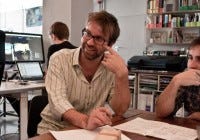
Featured Blog | This community-written post highlights the best of what the game industry has to offer. Read more like it on the Game Developer Blogs.
This We Believe - a design tool for creating different games
It's increasingly important to create games that stand out with original mechanics and features. Designer and studio director Alex Fleetwood describes "This We Believe" - a design tool that he's used for the last five years to do just that.

Last week, Flurry exec Simon Khalaf posted news of a 36 per cent drop in the amount of time Americans spend playing mobile games. The Gamasutra roundup of his post summarised three reasons he gave for the shift:
... not enough exciting new mobile games, a growing preponderance of games with in-app purchases players can make to avoid spending time grinding in-game, and a broader trend of people moving away from playing games in favor of watching other people play games.
I think that this is great news for independent developers. It suggests that distinctive games have the potential to reach decently-sized audiences. I would argue that the editorial direction that Apple are taking with Editor's Choice reinforces that opportunity. Originality becomes a key asset for discoverability.
With my new studio Sensible Object we're pushing into a fairly unexplored category for independent developers. We're making a game called Fabulous Beasts that combines physical and digital play. We hope to entice players away from the likes of Activision and Hasbro with something original and fun.
We made the prototype - a combination of custom electronics, 40 3D printed pieces and a connected iPad game - with a team of five people working over three months. At the start of that process, we used a design tool invented by Margaret Robertson (@ranarama) that we used a lot at Hide&Seek called This We Believe. Here's an excerpt from the final version for Fabulous Beasts:
We will make…
- a balancing game where the placement of every block has meaning.
- a game where the material & systemic properties of the pieces interact in delightful and unexpected ways
- a game where players both co-operate and compete.
- a game that is affordable to buy and add to.
Each of these statements (I aim for 7 - 10) is meant to be an aspiration - a goal that feels a bit out of reach to the design team. They tend to emerge from a set of playtests and discussions of existing games. For example, something that frustrated us about most analogue balancing games is that there is no reward for skilful play during the game, only a penalty for the person who knocks the tower down at the end. Nobody wins Jenga.
Over the first weeks of a project these statement are discussed and drafted down into their pithiest and loftiest form. If they feel a bit pretentious to you, it's because they are! They are kind of the opposite of Agile 'epic stories' - this is about reaching into uncharted territory, not declaring the exact thing you want your user to be able to do.
They are useful because they describe a possibility space that your team is going to try to chip away during a prototyping phase. They offer enough clarity to be able to refer to in the inevitable disputes that arise in the process of making something new, while being vague enough to allow you to move in unexpected and interesting directions.
They are especially handy in the context of diverse teams. The prototyping team consisted of a couple of mechanical engineers, a product designer, a game developer, an art director and me. That meant there was no easy shared language or prior history to rely on when discussing the thing we were making. Agreeing on a This We Believe up front creates a shared language that's specific to your project, co-owned by the design team.
About the Author(s)
You May Also Like








